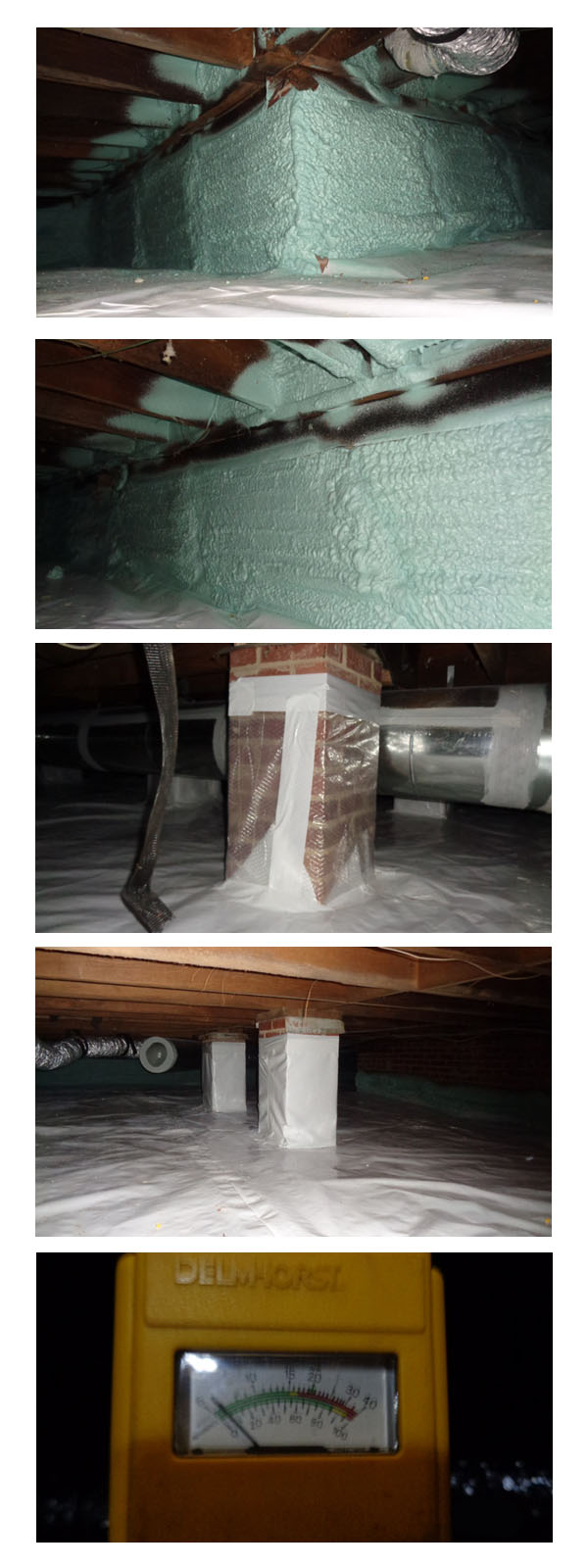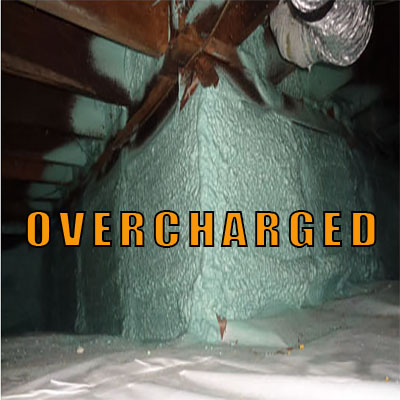LOCAL CRAWL SPACE SCIENCE COMPANIES MISDIAGNOSE SYMPTOMS AND ATTEMPT TO OVERCHARGE CUSTOMERS FOR UNNEEDED SERVICES IN NORTH CAROLINA. (PART 1)
I recently visited a customer in the Triad market that had some unique challenges to overcome with her crawl space. This customer had spent a fortune with a contractor waterproofing her basement and encapsulating her crawl space. A drain system was installed in the basement section connected to a sump pump. Inside the crawl space, all of the sub-floor insulation had been removed, a 20 mil liner installed over the crawl space soils, crawl space vents sealed, and a spray foam application installed along the curtain wall. A few pictures are attached for reference.
Since the contractor installed the system, this customer has been experiencing odors and smells that are percolating up from the crawlspace section of the house into the living areas of the home. This 3000 ft.² crawl space basically surrounds the small basement section in a U-shaped layout. The odors were becoming so intense that the customer was suffering respiratory irritations and other health problems from the off gassing of construction materials located inside the crawlspace. A basic inspection of the crawlspace section of the house confirmed the poor air quality and intense smell that was reported by the customer.
When homeowners invest in these types of systems they don’t realize that the application of heavy pool liners, spray foam resins, soil gas release, and the effect of other installed construction materials present inside the crawlspace can off gas unpleasant odors inside the space and potentially up into the living areas of the home. Because the crawlspace vents are sealed, no outside air exchange is possible to allow fresh air to integrate into the crawlspace environment and/or allow polluted air to escape outside. The heavier concentrations of construction materials installed in a crawl space only heighten the chances of polluting the crawl space and adjacent living area environments with the contaminated air.
This customer was at wits end with this problem. She was even considering moving out of the house as a last resort. Her concern was obvious, as she could not live happily in her own home, and she could not sell the home until this problem was resolved. The customer reached out to several companies to assist in diagnosing and resolving this issue with no success. Two local companies in particular attempted to sell thousands of dollars of additional products and equipment that will do absolutely nothing for the odors and smells problem that was reported. Both companies wanted to sell the client a $2000 commercial dehumidifier for the crawlspace. This advice was not only problematic, but completely ignorant of the situation at hand. The wood moisture reading at the time of the inspection was only 7% which is actually too dry. The customer actually already has a forced air HVAC conversion that services the crawl space environment and appears to be keeping the crawl space adequately dry. This was missed by both companies. As a matter of fact, according to the customer, wood moisture readings were never taken by the sales people from either company. If this was a true fact, how could a proper diagnosis of the symptoms be made? Simple. They cant. Incidentally, adding a dehumidifier into the crawl space environment on this house would only waste energy and actually over dry the floor system and potentially cause the expensive hardwoods upstairs to crack. One of the companies also proposed installing a negative air fan under the crawl space liner as a possible remedy to exhaust the smells. This recommendation is also problematic.
Basically, the company recommended installing a Radon mitigation fan under the liner with the duo task of removing odors. First of all, there are no radon problems on this house. Second, a network of drain tiles installed under the liner to an exhaust fan would not carry enough CFM air flow to turn over the crawl space air environment at the necessary pace to remove the odors and smells. Especially above the sealed liner where there would be little to no effect. Not to mention there is no way to turn the fan off. Radon fans are installed to run constantly so unwanted air could be invited into the space to replace the air that is being exhausted causing potential moisture spikes during the summer months. Since this crawl space is already encapsulated, the contractor would have been forced to cut up and remove the current installed liner to install the drain tiles, and then charge for restoring the 20 mil liner to its’ original state. All in all, thousands of dollars in unnecessary work that would not have solved the problem.
So why was this mistake made by the crawl space science companies? Simple. Franchisees hire commissioned based sales teams. There is very little emphasis on developing advanced problem solving skills. Manufacturers and sales managers teach a canned approach or a one size fits all mentality for every situation. Sales people that are paid 100% commission have too much temptation to make a sale by embellishing symptoms, misdiagnosing symptoms are flat out inventing problems that are not there so they can over sell the job and make a higher commission. This kind of sales environment is not good for the consumer and actually encourages bad behavior by the franchisee.
The recommendation of adding a dehumidifier and/or installing negative air fans in this situation shows poor training, poor judgement, lack of education, and/or just a blatant attempt to earn a commission. Not to actually solve a problem with any certainty. Dehumidifiers reduce moisture. They don’t purify air, and they bleed energy. Negative air fans don’t reduce odors and smells, they create negative pressure, and bleed energy. One company even attempted to sell the customer additional waterproofing programs in the basement and crawl space environments. This diagnosis was ridiculous as the crawlspace and basement sections were completely dry at the time of the inspection. The only item discovered that needed to be addressed was a broken sump pump in the basement sump area. This is a $185 problem, and it was handled during our mobilization.
The good news is there is a happy ending to the story! We were able to install an Atmox Controlled Ventilation System on this home to mitigate the odors and smells issue reported by the customer for a fraction of the cost proposed by others. This advanced system developed by engineers is the only product of its’ kind in the United States. This system is a network of low voltage fans controlled by a factor of dew point. We were able to open up a select few crawlspace vents to bring in outside air, and exhaust the stale air out in a controlled way that regulates moisture, as well as maintaining crawlspace air quality without the use of an expensive dehumidifier. No additional waterproofing products were needed on this house. Within 24 hours all odors and smells were completely eliminated to the immense joy of the homeowner. The customer now enjoys a comprehensive warranty transferable if she chooses to sell the home. The customer was completely satisfied with the results and very grateful for an accurate diagnosis. For more information on controlled ventilation systems please feel free to reach out to us for a free consultation. We are an independent network of companies not affiliated with franchisees. We do not use commissioned based sales people for our site consultations. So remember, conduct thorough research before making decisions on crawl space science and remember, Don’t Encapsulate! Ventilate!
Best Regards,
Michael P. Masserang
Crawl Space Air Quality Specialist
Masserang Consulting
704-787-6972


